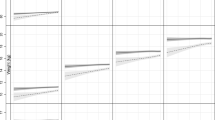Abstract
Objective
To assess the growth, adiposity and blood pressure of non-handicapped low birthweight children at 18 years.
Design
Prospective cohort study.
Setting
Infants born between 1987-1989 with birthweight less than 2000g, discharged from a neonatal special care unit of a referral hospital and followed up till the age of 18 years.
Methods
The height, weight, and head circumference were measured. Measurements for adiposity, blood pressure, parental height and weight were recorded.
Results
The cohort of 161 low birth weight (LBW) infants was divided into three groups according to their gestation — preterm SGA (n=61), full term SGA (n=30) and preterm AGA (n=70). 71 full term AGA infants served as controls. Preterm SGA males had height of 164.5 cms (162–166.9, 95% CI) which was significantly less (mean deficit = 5.7 cms) than that of controls (P=0.02). However, PTSGA children were short inspite of normal midparental height. Preterm SGA and AGA children had smaller head circumference. There was no evidence of adiposity and no child had hypertension. Mid-parental height was an important determinant of height in LBW children. Both parentss’ weight and BMI were important determinants of weight and BMI, respectively in all LBW children.
Conclusion
Preterm SGA males were short, but there was no difference in the weight of the LBW group and controls. Preterms had smaller head circumference. There was no evidence of adiposity or hypertension.
Similar content being viewed by others
References
National Neonatal-Perinatal Database NNPD Network. Indian Council of Medical Research. 2002;2003:25.
Leger J, Marchal CL, Bloch J, Pinet A, Porquet D, Czernichow P. Reduced final height and indications for insulin resistance in 20 years olds born small for gestational age: regional cohort study. BMJ. 1997;315:341–347.
Paz I, Seidman DS, Danon YL, Laor A, Stevenson DK, Gale R. Are children born small for gestational age at increased risk of short stature? Am J Dis Child Pediatr Res. 1993;147:337–339.
Barker DJP, Hales CN, Fall CHD, Osmond C, Phipps K, Clark PMC. Type 2 (non-insulin-dependent) diabetes mellitus, hypertension and hyperlipidemia (syndrome X): relation to reduced foetal growth. Diabetologia. 1993;36:62–67.
Frankel S, Elwood P, Swertham P, Yarnell J, Davey Smith E. Birthweight, body mass index and incident coronary heart disease. Lancet. 1996;348:1478–1480.
Hack M, Schluchter M, Cartar L, Mabhoob R, Cutter L, Borawski E. Growth of very low birth weight infants to age 20 year. Pediatrics. 2003;112:e30–38.
Saigal S, Stoskopf B, StreIner D, Paneth N, Pinneli J, Boyle M. Growth trajectories of extremely low birth weight infants from birth to young adulthood: a longitudinal population based study. Pediatr Res. 2006;60:751–758.
Chaudhari S, Otiv M, Hoge M, Pandit A, Mote A. Growth and sexual maturation of low birth weight infants at early adolescence. Indian Pediatr. 2008;45:191–198.
Chaudhari S, Kulkarni S, Pandit A, Deshmukh S. Mortality and morbidity in high risk infants during a six year follow up. Indian Pediatr. 2000;37;1314–1320.
Chaudhari S, Otiv M, Chitale A, Hoge M, Pandit A, Mote A. Biology versus environment in low birth weight children. Indian Pediatr. 2005;42:763–770.
Chaudhari S, Otiv M, Chitale A, Pandit A, Hoge M. Pune low birth weight study — cognitive abilities and educational performance at twelve years. Indian Pediatr. 2004;41:121–128.
Singh M. Care of the Newborn. 4thedn. New Delhi, Sagar Publications. 1979:2.
Tanner JM. Normal growth and techniques of growth assessment. Clin Endocrinol Metab. 1986;3:411–451.
Agarwal DK, Agarwal KN. Physical growth in Indian affluent children (Birth - 6 years) Indian Pediatr. 1994;31:377–413.
Agarwal DK, Agarwal KN, Upadhyay SK, Mittal R, Prakash R, Rai S. Physical and sexual growth pattern of affluent Indian children from 6 to 18 years of age. Indian Pediatr. 1992;29:1203–1283.
Tanner JM, Whitehouse RH, Marshall WA, Healey MJR, Goldstein H. Assessment of skeletal maturity and prediction of adult height (TW II) method. London, Academic Press. 1975.
Tanner JM. Growth at adolescence 2nd. edn. Oxford Blackwell Scientific Publication. 1962.
Cole TJ, Bellizzi MC, Flegal KM, Deitz WH. Establishing a standard definition for child overweight and obesity worldwide. International survey. BMJ. 2000;320:1–5.
McCarthy HD, Jarrett KV, Crawley HF. The development of waist circumference percentiles in British children aged 5–16.9 years. Eur J Clin Nutr. 2001;55:902–907.
Taylor RW, Jones JE, Williams SM, Goulding A. Evaluation of waist circumference, waist to hip ratio and the tonicity index as screening tools for high trunk mass, as measured by dual energy. X ray absorptiometry in children aged 3–19 years. Am J Clin Nutr. 1989;69:308–317.
McCarthy HD, Ashwell M. A study of central fatness using waist to height ratios in UK children and adolescents over two decades supports the simple ménage “ keep your waist circumference to less than half of your height.” Int J Obes. 2006;30:988–992.
Durnin JYGA, Womersley J. Body fat assessed from total body density and its estimation from skinfold thickness: measurements on 481 men and women aged 16–72 years. Br J Nutr. 1974;32:77–94.
Odberg MD, Sommerfelt K, Markestad T, Elgen IB. Growth and somatic health until adulthood of low birthweight children. Arch Dis Child Foetal Neonatal Ed. 2010;95:F201–F205.
Kuppuswamy B. Manual of socio-economic status (Revised) Manasayan, New Delhi, 1991.
Ranke MB, Vollmer B, Traunecker R, Wollman HA, Goelz RR, Seibolweiger K. Growth and development are similar in VLBW children born appropriate and small for gestational age: an interim report of 97 preschool children. J Pediatr Endocrinol Metab. 1997;20:1017–1026.
Doyle LW, Faber B, Callanan C, Morley R. Blood pressure in late adolescence and very low birth weight. Pediatrics. 2003;111:252–257.
Hack M, Schluchter M, Cartar L. Blood pressure among very low birth weight (<1.5kg) young adults. Pediatr Res. 2005;58:677–684.
Author information
Authors and Affiliations
Corresponding author
Rights and permissions
About this article
Cite this article
Chaudhari, S., Otiv, M., Khairnar, B. et al. Pune low birth weight study — Growth from birth to adulthood. Indian Pediatr 49, 727–732 (2012). https://doi.org/10.1007/s13312-012-0165-7
Received:
Revised:
Accepted:
Published:
Issue Date:
DOI: https://doi.org/10.1007/s13312-012-0165-7




